Pre-Columbian era: Difference between revisions
→History: ce |
|||
| Line 135: | Line 135: | ||
===Inca Empire=== |
===Inca Empire=== |
||
{{Main|Inca Empire}} |
{{Main|Inca Empire}} |
||
Holding their capital |
Holding their capital adt the great [[cougar]]-shaped city of [[Cuzco]], the Inca civilization dominated the Andes region from 1438 to 1533. Known as ''Tawantin suyu'', or "the land of the four regions", in [[Quechua]], the Inca civilization was highly distinct and developed. Inca rule extended to nearly a hundred linguistic or ethnic communities, some 9 to 14 million people connected by a 25,000 kilometer [[Inca road system|road system]]. Cities were built with precise, unmatched stonework, constructed over many levels of mountain terrain. [[Terrace farming]] was a useful form of agriculture. There is evidence of excellent metalwork and even successful [[brain surgery]] in Inca civilization. |
||
{{wide image|95 - Machu Picchu - Juin 2009.jpg|600px|The iconic [[Machu Picchu]], symbol of the Inca civilization.|center}} |
{{wide image|95 - Machu Picchu - Juin 2009.jpg|600px|The iconic [[Machu Picchu]], symbol of the Inca civilization.|center}} |
||
{{clr}} |
{{clr}} |
||
Revision as of 17:30, 4 September 2010
| Ancient history |
|---|
| Preceded by prehistory |
|
The pre-Columbian era incorporates all period subdivisions in the history and prehistory of the Americas before the appearance of significant European influences on the American continents, spanning the time of the original settlement in the Upper Paleolithic period to European colonization during the Early Modern period.
While technically referring to the era before Christopher Columbus' voyages of 1492 to 1504, in practice the term usually includes the history of American indigenous cultures until they were conquered or significantly influenced by Europeans, even if this happened decades or even centuries after Columbus' initial landing.
Pre-Columbian is used in the context of discussing the great indigenous civilizations of the Americas, such as those of Mesoamerica: the Olmec, the Toltec, the Teotihuacano, the Zapotec, the Mixtec, the Aztec, and the Maya; and South America: Norte Chico or Caral in Peru, and the Andean civilizations: Inca, Moche, Chibcha, and Cañaris. It is also applied to the Mississippian culture of North America, which produced Cahokia; at its peak in 1250 CE, it was the largest city north of Mexico, a position not surpassed until 1800.
Many pre-Columbian civilizations established hallmarks which included permanent or urban settlements, agriculture, civic and monumental architecture, major earthworks, and complex societal hierarchies. Some of these civilizations had long faded by the time of the first permanent European arrivals (c. late 15th–early 16th centuries), and are known only through archaeological investigations. Others were contemporary with the colonial period, and were described in historical accounts of the time. A few, such as the Maya, had their own written records. Because most Christian Europeans of the time viewed such texts as heretical, they destroyed many texts in pyres. Only a few hidden documents have survived to today, giving modern historians glimpses of ancient culture and knowledge.
American civilizations at the time of European encounter possessed many impressive accomplishments. For instance, the Aztecs built one of the most impressive cities in the world, Tenochtitlan, the ancient site of Mexico City, with an estimated population of 200,000. American civilizations also displayed impressive accomplishments in astronomy and mathematics.
Where they persist, the societies and cultures that descended from these civilizations may now be substantively different in form from that of earlier ones. Many of these peoples and their descendants maintain various traditions and practices which relate to the earlier times, as well as combining them with more recently adopted ones.
History
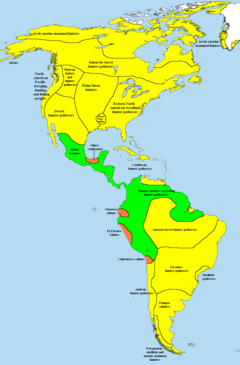

Asiatic migration
Asian nomads are thought to have entered the Americas via the Bering Land Bridge (Beringia), now the Bering Strait and possibly along the Northwest coast. Genetic evidence found in Amerindians' maternally inherited mitochondrial DNA (mtDNA) supports the theory of multiple genetic founding populations migrating from Asia, although it does not rule out a single migration. Over the course of millennia, Paleo-Indians spread throughout North America and South America. Exactly when the first group of people migrated into the Americas is the subject of much debate. One of the earliest identifiable cultures was the Clovis culture, with sites dating from some 13,000 years ago. However, older sites dating back to 20,000 years ago have been claimed. Some genetic studies estimate the colonization of the Americas dates from between 40,000 to 13,000 years ago. Also, multiple waves of immigration have been suggested.[1][2]
The chronology of migration models is currently divided into two general approaches. The first is the short chronology theory with the first movement beyond Alaska into the New World occurring no earlier than 14,000 – 17,000 years ago, followed by successive waves of immigrants.[3][4][5][6] The second belief is the long chronology theory, which proposes that the first group of people entered the hemisphere at a much earlier date, possibly 50,000 - 40,000 years ago or earlier.[7][8][9][10]
Artifacts have been found in both North and South America which have been dated to 14,000 BP[11], and humans are thought to have reached Cape Horn at the southern tip of South America by this time. Most scholars agree that the Inuit and related peoples arrived separately and at a much later date, probably during the first millennium CE, moving across the ice from Siberia into Alaska.
North America
After the migration or migrations, it was several thousand years before the first complex civilizations arose, at the earliest emerging 5000 BCE. The inhabitants of the Americas were hunter-gatherers. Even after the emergence of advanced civilizations, hunter-gatherers inhabited most of the continents' area until the 18th century. Numerous archaeological cultures can be identified with some of the classifications, including Early Paleo-Indian Period, Late Paleo-Indian Period, Archaic Period, Early Woodland Period, Middle Woodland Period, and Late Woodland Period.
Early Paleoamericans soon spread throughout the Americas, diversifying into many hundreds of culturally distinct nations and tribes.[12] Paleoindian adaptation across North America was likely characterized by small, highly mobile bands consisting of approximately 20 to 50 members of an extended family. These groups moved from place to place as preferred resources were depleted and new supplies were sought.[13] Paleoindian groups were efficient hunters and carried a variety of tools. These included highly efficient PP/Ks of the types mentioned above[ambiguous], as well as less distinctive implements used for butchering and hide processing. During much of the Paleoindian period, bands are thought to have subsisted primarily through hunting now-extinct megafauna such as mastodon and bison.[14]
The North American climate finally stabilized by 8000 BCE, climatic conditions were very similar to today's.[15] This led to wide spread migration, cultivation and subsequently a dramatic rise in population all over the Americas.[15] Over the course of thousands of years, American indigenous peoples domesticated, bred and cultivated a large array of plant species. These species now constitute 50–60% of all crops in cultivation worldwide.[16] The vastness and variety of the climates, ecology, vegetation, fauna, and landforms separations have define ancient peoples implicitly as cultural or linguistic divisions. The identity of a people is in part created by language because language influences social life ways and spiritual practices.[17] According to the oral histories of many of the indigenous peoples of the Americas, they have been living there since their genesis, described by a wide range of traditional creation accounts.
When the Europeans arrived, many natives of North America were semi-nomadic tribes of hunter-gatherers; others were sedentary and agricultural civilizations. Many formed new tribes or confederations in response to European colonization. Well-known groups included the Huron, Haida, Apache, Cherokee, Sioux, Delaware, Algonquin, Choctaw, Mohegan, Iroquois (which included Mohawk, Oneida, Seneca, Cayuga, Onondaga and later the Tuscarora tribe), and Inuit. Although not as technologically advanced as the Mesoamerican civilizations further south, there were extensive pre-Columbian sedentary societies in what is now the United States of America. The Iroquois League of Nations or "People of the Long House" was a politically advanced and unique social structure that was at the very least inspirational if not directly influential on the later development of the democratic United States government, a departure from the strong monarchies from which the Europeans came.
Woodland period
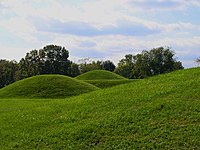
The Woodland period of North American pre-Columbian cultures refers to the time period from roughly 1000 BCE to 1000 CE in the eastern part of North America. The term "Woodland" was coined in the 1930s and refers to prehistoric sites between the Archaic period and the Mississippian cultures. The Adena culture and the ensuing Hopewell tradition during this period built monumental architecture and established continent spanning trade and exchange networks.
This period is considered a developmental stage without any massive changes in a short period, but instead having a continuous development in stone and bone tools, leather working, textile manufacture, tool production, cultivation, and shelter construction. Some Woodland peoples continued to use spears and atlatls until the end of the period when they were replaced by bows and arrows.
Mississippian Culture

The Mississippian culture was spread across the Southeast and Midwest from the Atlantic coast to the edge of the plains, from the Gulf of Mexico to the Upper Midwest, although most intensively in the area along the Mississippi River. One of the distinguishing features of this culture was the construction of large earthen mounds, continuing the moundbuilding traditions of earlier cultures. They grew maize and other crops intensively, participated in an extensive trade network, and had a complex stratified society. The Mississippians first appeared around 1000 CE, following and developing out of the less agriculturally intensive and less centralized Woodland period. The largest site of this people, Cahokia — located near modern East St. Louis, Illinois — may have reached a population of over 20,000. At its peak, between the 12th and 13th centuries, Cahokia was the most populous city in North America, although far larger cities were constructed in Mesoamerica and South America. Monk's Mound, the major ceremonial center of Cahokia, remains the largest earthen construction of the prehistoric New World. The culture reached its peak in c. 1200-1400, and in most places it seems to have been in decline before the arrival of the Europeans. Many Mississippian groups were met by the Hernando de Soto Expedition of the 1540s, mostly with disastrous results for both sides. Unlike the Spanish expeditions in Mesoamerica who conquered vast empires with relatively few men, the de Soto expedition wandered the American Southeast for four years, becoming more bedraggled, losing more men and equipment, and eventually arriving in Mexico a fraction of its original size. The local people fared much worse though, as the social disruption and diseases introduced by the expedition devastated the populations. By the time Europeans returned a hundred years later, nearly all of the Mississippian groups had vanished, and vast swaths of their territory were virtually uninhabited.[18].
Mesoamerica
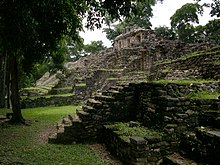
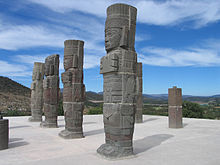
Mesoamerica is the region extending from central Mexico south to the northwestern border of Costa Rica that gave rise to a group of stratified, culturally related agrarian civilizations spanning an approximately 3,000-year period before the European discovery of the New World by Christopher Columbus. Mesoamerican is the adjective generally used to refer to that group of pre-Columbian cultures. This refers to an environmental area occupied by an assortment of ancient cultures that shared religious beliefs, art, architecture, and technology in the Americas for more than three thousand years.
Between 1800 and 300 BCE, complex cultures began to form in Mesoamerica. Some matured into advanced pre-Columbian Mesoamerican civilizations such as the Olmec, Teotihuacan, Maya, Zapotec, Mixtec, Huastec, Purepecha, Toltec, and Mexica (Aztecs), which flourished for nearly 4,000 years before first contact with Europeans.
These indigenous civilizations are credited with many inventions in: building pyramid-temples, mathematics, astronomy, medicine, writing, highly accurate calendars, fine arts, intensive agriculture, engineering, an abacus calculator, a complex theology, and the wheel. However, without any draft animals, the wheel was used only as a toy. They also used native copper and gold for metalworking.
Archaic inscriptions on rocks and rock walls all over northern Mexico (especially in the state of Nuevo León) demonstrate an early propensity for counting in Mexico. The counting system was one of the most complex in the world, with a base 20 number system. These very early and ancient count-markings were associated with astronomical events and underscore the influence that astronomical activities had upon Mexican natives before the arrival of Europeans. In fact, many of the later Mexican based civilizations carefully built their cities and ceremonial centers according to specific astronomical events.
The biggest Mesoamerican cities such as Teotihuacan, Tenochtitlan, and Cholula were among the largest in the world. These cities grew as centers of commerce, ideas, ceremonies, and theology, and they radiated influence outwards onto neighboring cultures in central Mexico.
While many city-states, kingdoms, and empires competed with one another for power and prestige, Mesoamerica can be said to have had five major civilizations: The Olmec, Teotihuacan, the Toltec, the Mexica and the Maya. These civilizations (with the exception of the politically fragmented Maya) extended their reach across Mexico—and beyond—like no others. They consolidated power and distributed influence in matters of trade, art, politics, technology, and theology. Other regional power players made economic and political alliances with these four civilizations over the span of 4,000 years. Many made war with them, but almost all peoples found themselves within these five spheres of influence.
Olmec civilization
The earliest known civilization is the Olmec. This civilization established the cultural blueprint by which all succeeding indigenous civilizations would follow in Mexico. Olmec civilization began with the production of pottery in abundance, around 2300 BCE. Between 1800 and 1500 BCE, the Olmec consolidated power into chiefdoms which established their capital at a site today known as San Lorenzo Tenochtitlán, near the coast in southeast Veracruz. The Olmec influence extended across Mexico, into Central America, and along the Gulf of Mexico. They transformed many peoples' thinking toward a new way of government, pyramid-temples, writing, astronomy, art, mathematics, economics, and religion. Their achievements paved the way for the greatness of the Maya civilization in the east and the civilizations to the west in central Mexico.
Teotihuacan civilization
The decline of the Olmec resulted in a power vacuum in Mexico. Emerging from that vacuum was Teotihuacan, first settled in 300 BCE. By 150 CE, Teotihuacan had risen to become the first true metropolis of what is now called North America. Teotihuacan established a new economic and political order never before seen in Mexico. Its influence stretched across Mexico into Central America, founding new dynasties in the Maya cities of Tikal, Copan, and Kaminaljuyú. Teotihuacan's influence over the Maya civilization cannot be understated: it transformed political power, artistic depictions, and the nature of economics. Within the city of Teotihuacan was a diverse and cosmopolitan population. Most of the regional ethnicities of Mexico were represented in the city, such as Zapotecs from the Oaxaca region. They lived in apartment communities where they worked their trades and contributed to the city's economic and cultural prowess. By 500 CE, Teotihuacan had become the largest city in the world. Teotihuacan's economic pull impacted areas in northern Mexico as well. It was a city whose monumental architecture reflected a monumental new era in Mexican civilization, declining in political power about 650 CE—but lasting in cultural influence for the better part of a millennium, to around 950 CE.

Maya civilization
Contemporary with Teotihuacan's greatness was the greatness of the Maya civilization. The period between 250 CE and 650 CE was a time of intense flourishing of Maya civilized accomplishments. While the many Maya city-states never achieved political unity on the order of the central Mexican civilizations, they exerted a tremendous intellectual influence upon Mexico and Central America. The Maya built some of the most elaborate cities on the continent, and made innovations in mathematics, astronomy, and calendrics. The Mayans also evolved the only true written system native to the Americas using pictographs and syllabic elements in the form of texts and codices inscribed on stone, pottery, wood, or highly perishable books made from bark paper.
Aztec/Mexica civilization
With the decline of the Toltec civilization came political fragmentation in the Valley of Mexico. Into this new political game of contenders to the Toltec throne stepped outsiders: the Mexica. They were also a desert people, one of seven groups who formerly called themselves "Azteca", in memory of Aztlán, but they changed their name after years of migrating. Since they were not from the Valley of Mexico, they were initially seen as crude and unrefined in the ways of Nahua civilization. Through political maneuvers and ferocious fighting skills, they managed to become the rulers of Mexico as the head of the 'Triple Alliance' (which included two other "Aztec" cities, Texcoco and Tlacopan).
Latecomers to Mexico's central plateau, the Mexica thought of themselves, nevertheless, as heirs of the civilizations that had preceded them. For them, arts, sculpture, architecture, engraving, feather-mosiac work, and the calendar, were because of the former inhabitants of Tula, the Toltecs.
The Mexica-Aztecs were the rulers of much of central Mexico by about 1400 (while Yaquis, Coras and Apaches commanded sizable regions of northern desert), having subjugated most of the other regional states by the 1470s. At their peak, 300,000 Mexica[citation needed] presided over a wealthy tribute-empire comprising about 10 million people[citation needed] (almost half of Mexico's 24 million[citation needed] people). The modern name "Mexico" comes from their name.
Their capital, Tenochtitlan, is the site of modern-day capital of Mexico, Mexico City. At its peak, it was one of the largest cities in the world[citation needed] with population estimates of 300,000[citation needed]. The market established there was the largest ever seen by the conquistadors on arrival.
South America
By the first millennium, South America’s vast rainforests, mountains, plains, and coasts were the home of tens of millions of people. Some groups formed permanent settlements. Among those groups were the Chibchas (or "Muiscas" or "Muyscas"), Valdivia and the Tairona. The Chibchas of Colombia, Valdivia of Ecuador, the Quechuas of Peru, and the Aymara of Bolivia were the four most important sedentary Amerindian groups in South America.
The theory of pre-Columbian contact across the South Pacific Ocean between South America and Polynesia has received support from several lines of evidence, although solid confirmation remains elusive. A diffusion by human agents has been put forward to explain the pre-Columbian presence in Oceania of several cultivated plant species native to South America, such as the bottle gourd (Lagenaria siceraria) or sweet potato (Ipomoea batatas). Direct archaeological evidence for such pre-Columbian contacts and transport has been lacking, however. A 2007 paper published in PNAS put forward DNA and archaeological evidence that domesticated chickens had been introduced into South America via Polynesia by late pre-Columbian times.[19] These findings were challenged by a later study published in the same journal, that cast doubt on the dating calibration used and presented alternative mtDNA analyses that disagreed with a Polynesian genetic origin.[20] The origin and dating remains an open issue. Whether or not early Polynesian-American exchanges occurred, there are no discernible human-genetic, archaeological, cultural or linguistic legacies of that contact.
Norte Chico or Caral
On the north-central coast of present-day Peru, Norte Chico or Caral (as known in Peru) was a civilizaton that emerged around 3000 BCE (contemporary with urbanism's rise in Mesopotamia.) It is considered one of the six places where civilization has arisen independently in the world. It had a cluster of large-scale urban settlements of which the Sacred City of Caral, in the Supe valley, is one of the largest and best studied sites. Norte Chico or Caral is the oldest known civilization in the Americas and persisted until around 1800 BCE.
Valdivia
The Valdivia culture was concentrated on the coast of Ecuador. Their existence was recently discovered by archeological findings. Their culture is the oldest in the Americas, spanning from 3500 to 1800 BCE. The Valdivia lived in a community of houses built in a circle or oval around a central plaza. They were sedentary people who lived off farming and fishing, though occasionally they hunted for deer. From the remains that have been found, scholars have determined that Valdivians cultivated maize, kidney beans, squash, cassava, hot peppers, and cotton plants, the last of which was used to make clothing. Valdivian pottery initially was rough and practical, but it became showy, delicate, and big over time. They generally used red and gray colors; and the polished dark red pottery is characteristic of the Valdivia period. In its ceramics and stone works, the Valdivia culture shows a progression from the most simple to much more complicated works.
Cañaris
The Cañari were the indigenous natives of today's Ecuadorian provinces of Cañar and Azuay. They were an elaborate civilization with advanced architecture and complex religious belief. The Inca destroyed and burned most of their remains. The Cañari's old city was replaced twice, first by the Incan city of Tomipamba, and later by the colonial city of Cuenca. The city was also believed to be the site of El Dorado, the city of gold from the mythology of Colombia. (see Cuenca)
The Cañari were most notable for having repelled the Incan invasion with fierce resistance for many years until they fell to Tupac Yupanqui. Many of their descendants are still present in Cañar. The majority did not mix with the colonists or become Mestizos.
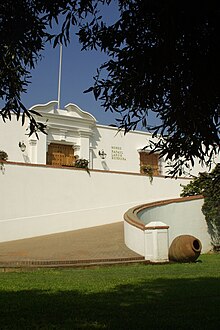
Chavín
The Chavín, a South American preliterate civilization, established a trade network and developed agriculture by 900 BCE, according to some estimates and archeological finds. Artifacts were found at a site called Chavín in modern Peru at an elevation of 3,177 meters. The Chavín civilization spanned from 900 to 300 BCE.
Chibchas
The Chibcha linguistic communities were the most numerous, the most territorially extended and the most socio-economically developed of the pre-Hispanic Colombians. By the 3rd century, the Chibchas had established their civilization in the northern Andes. At one point, the Chibchas occupied part of what is now Panama, and the high plains of the Eastern Sierra of Colombia.
The areas which they occupied in Colombia were the present-day Departments of Santander (North and South), Boyacá and Cundinamarca. This is where the first farms and industries were developed. It is also where the independence movement originated. They are currently the richest areas in Colombia. The Chibcha developed the most populous zone between the Mayan and Inca empires. Next to the Quechua of Peru and the Aymara in Bolivia, the Chibcha of the eastern and north-eastern Highlands of Colombia developed the most notable culture among the sedentary indigenous peoples in South America.
In the Oriental Andes, the Chibcha comprised several tribes who spoke the same language (Chibchan). They included the following: the Muisca, Guane, Lache, Cofán, and Chitarero.
Moche
The Moche thrived on the north coast of Peru approximately 1,500–2,000 years ago. The heritage of the Moche is seen in their elaborate burials. Some were recently excavated by UCLA's Christopher Donnan in association with the National Geographic Society.
As skilled artisans, the Moche were a technologically advanced people. They traded with distant peoples such as the Maya. What has been learned about the Moche is based on study of their ceramic pottery; the carvings reveal details of their daily lives. The Larco Museum of Lima, Peru has an extensive collection of such ceramics. They show that the people practiced human sacrifice, had blood-drinking rituals, and that their religion incorporated non-procreative sexual practices (such as fellatio).
Inca Empire
Holding their capital adt the great cougar-shaped city of Cuzco, the Inca civilization dominated the Andes region from 1438 to 1533. Known as Tawantin suyu, or "the land of the four regions", in Quechua, the Inca civilization was highly distinct and developed. Inca rule extended to nearly a hundred linguistic or ethnic communities, some 9 to 14 million people connected by a 25,000 kilometer road system. Cities were built with precise, unmatched stonework, constructed over many levels of mountain terrain. Terrace farming was a useful form of agriculture. There is evidence of excellent metalwork and even successful brain surgery in Inca civilization.
Agricultural development
Early inhabitants of the Americas developed agriculture, developing and breeding maize (corn) from ears 2–5 cm in length to the current size we are familiar with today. Potatoes, tomatoes, tomatillos (a husked green tomato), pumpkins, chili peppers, squash, beans, pineapple, sweet potatoes, the grains quinoa and amaranth, chocolate, vanilla, onion, peanuts, strawberries, raspberries, blueberries, blackberries, papaya, and avocados were among other plants grown by natives. Over two-thirds of all types of food crops grown worldwide are native to the Americas.
The natives began using fire in a widespread manner. Intentional burning of vegetation was taken up to mimic the effects of natural fires that tended to clear forest understories, thereby making travel easier and facilitating the growth of herbs and berry-producing plants that were important for both food and medicines. This created the Pre-Columbian savannas of North America.[21]
While not as widespread as in other areas of the world (Asia, Africa, Europe), native Americans did have livestock. In Mexico as well as Central America, natives had domesticated deer which was used for meat and possibly even milk. Andean societies had llamas and alpacas for the same reasons, as well as for beasts of burden. Guinea pigs were raised for meat in the Andes. Iguanas were another source of meat in Mexico, Central, and northern South America.
By the 15th century, maize had been transmitted from Mexico and was being farmed in the Mississippi embayment and as far as the East Coast of the United States and as far north as southern Canada. Potatoes were utilized by the Inca, and chocolate was used by the Aztec.
Genetics

The haplogroup most commonly associated with Indigenous Amerindian genetics is Haplogroup Q1a3a (Y-DNA).[22] Y-DNA, like mtDNA, differs from other nuclear chromosomes in that the majority of the Y chromosome is unique and does not recombine during meiosis. This has the effect that the historical pattern of mutations can easily be studied.[23] The pattern indicates Indigenous Amerindians experienced two very distinctive genetic episodes; first with the initial-peopling of the Americas, and secondly with European colonization of the Americas.[24][25] The former is the determinant factor for the number of gene lineages and founding haplotypes present in today's Indigenous Amerindian populations.[24]
Human settlement of the New World occurred in stages from the Bering sea coast line, with an initial 20,000-year layover on Beringia for the founding population.[26][27] The micro-satellite diversity and distributions of the Y lineage specific to South America indicates that certain Amerindian populations have been isolated since the initial colonization of the region..[28] The Na-Dené, Inuit and Indigenous Alaskan populations exhibit haplogroup Q (Y-DNA) mutations, however are distinct from other indigenous Amerindians with various mtDNA mutations.[29][30][31] This suggests that the earliest migrants into the northern extremes of North America and Greenland derived from later populations.[32]
See also
- List of pre-Columbian civilizations
- Metallurgy in pre-Columbian America
- Pre-Inca cultures in Peru
- Pre-Columbian trans-oceanic contact
- Pre-Columbian population
Notes
References
- Brown, Michael D. (1998). "mtDNA haplogroup X: An ancient link between Europe/Western Asia and North America?" (PDF online reproduction at PubMed). American Journal of Human Genetics. 63 (6). Cambridge, MA: Cell Press: 1852–1861. doi:10.1086/302155. ISSN 0002-9297. OCLC 207127248. PMC 1377656.
{{cite journal}}: Unknown parameter|coauthors=ignored (|author=suggested) (help); Unknown parameter|month=ignored (help) - Fernández-Armesto, Felipe (1987). Before Columbus: Exploration and Colonisation from the Mediterranean to the Atlantic: 1229-1492. New studies in medieval history series. Basingstoke, Hampshire: Macmillan Education. ISBN 0-333-40382-7. OCLC 20055667.
- Gongora, Jaime (2008). "Indo-European and Asian origins for Chilean and Pacific chickens revealed by mtDNA" (PDF online reproduction at PubMed). Proceedings of the National Academy of Sciences. 105 (30). Washington, DC: NAS: 10308–10313. doi:10.1073/pnas.0801991105. ISSN 0027-8424. OCLC 237029642. PMC 2492461.
{{cite journal}}: Unknown parameter|coauthors=ignored (|author=suggested) (help); Unknown parameter|month=ignored (help) - Mann, Charles C. (2005). 1491: New Revelations of the Americas Before Columbus. New York: Knopf. ISBN 978-1-4000-4006-3. OCLC 56632601.
- Schurr, Theodore G. (1990). "Amerindian mitochondrial DNAs have rare Asian mutations at high frequencies, suggesting they derived from four primary maternal lineages" (PDF online reproduction at PubMed). American Journal of Human Genetics. 46 (3). Cambridge, MA: Cell Press: 613–623. ISSN 0002-9297. OCLC 120356210. PMC 1683611.
{{cite journal}}: Unknown parameter|coauthors=ignored (|author=suggested) (help); Unknown parameter|month=ignored (help) - Sorenson, John L. (2006). "Biological evidence for pre-Columbian transoceanic voyages". In Victor H. Mair (ed.) (ed.). Contact and Exchange in the Ancient World. Perspectives on the global past series. Honolulu: University of Hawaiʻi Press. pp. 238–297. ISBN 0-8248-2884-4. OCLC 62896389.
{{cite book}}:|editor=has generic name (help); Unknown parameter|coauthors=ignored (|author=suggested) (help) - Storey, Alice A. (2007). "Radiocarbon and DNA evidence for a pre-Columbian introduction of Polynesian chickens to Chile" (PDF online reproduction at PubMed). Proceedings of the National Academy of Sciences. 104 (25). Washington, DC: NAS: 10335–10339. doi:10.1073/pnas.0703993104. ISSN 0027-8424. OCLC 144764031. PMC 1965514.
{{cite journal}}: Unknown parameter|coauthors=ignored (|author=suggested) (help); Unknown parameter|month=ignored (help) - Wright, Ronald (2005). Stolen Continents: 500 Years of Conquest and Resistance in the Americas (1st Mariner Books ed.). Boston, MA: Houghton Mifflin. ISBN 0-618-49240-2. OCLC 57511483.
External links
- Central Andes Prehistoric Sequence
- Pre Columbian textiles - Virtual Museum of Textile Arts
- McGuiness Publishing site on pre-Columbian archaeological topics
- Arqueologia Iberoamericana - Open access international scientific journal devoted to the archaeological study of the American and Iberian peoples. It contains numerous research articles on pre-Columbian America.


